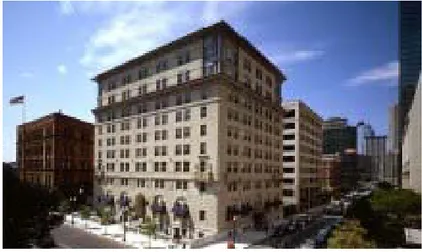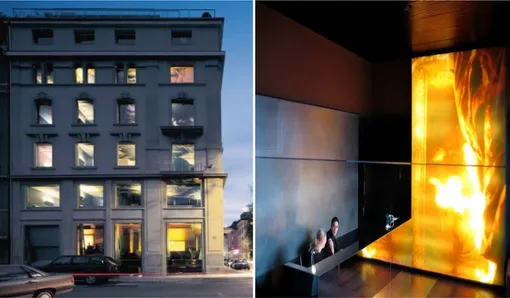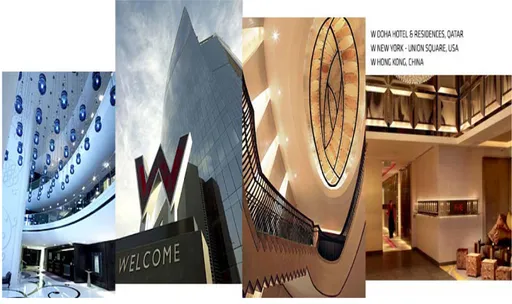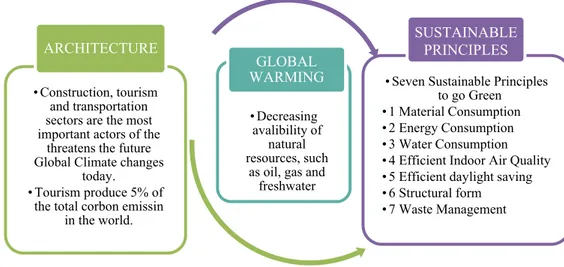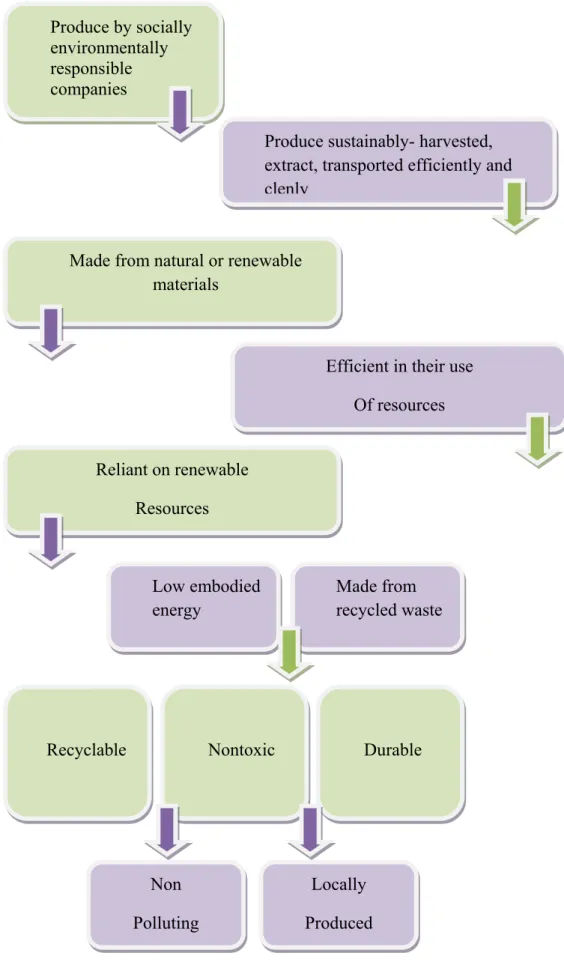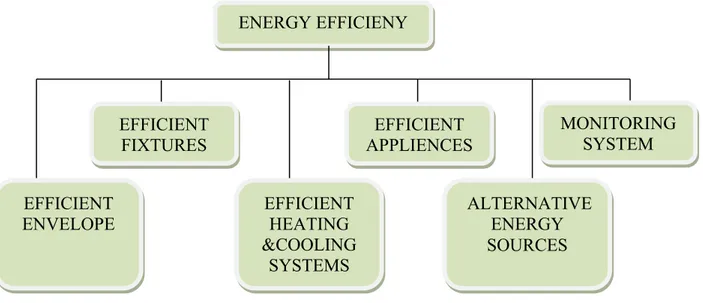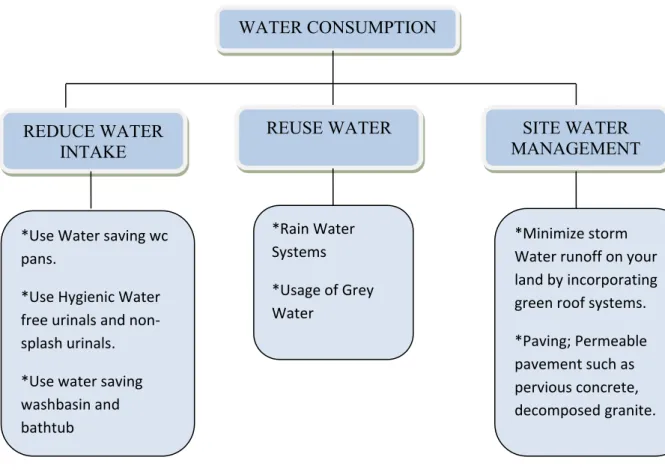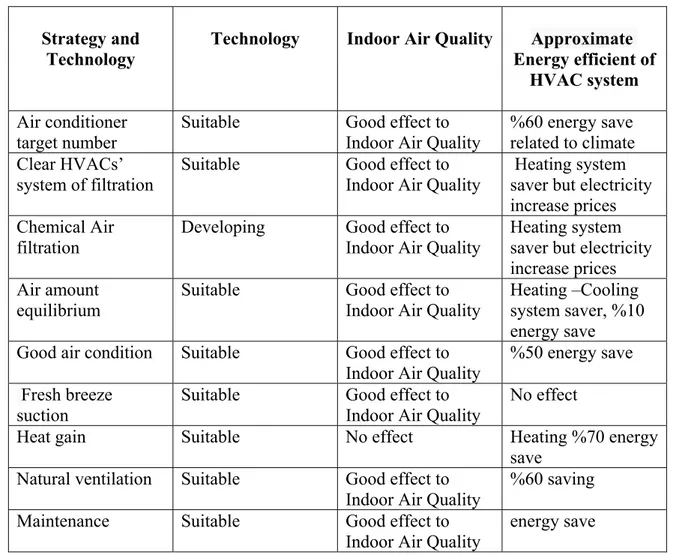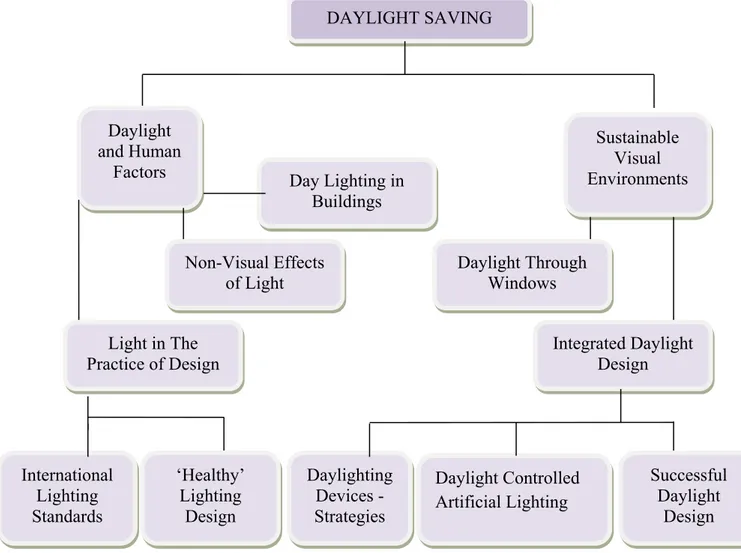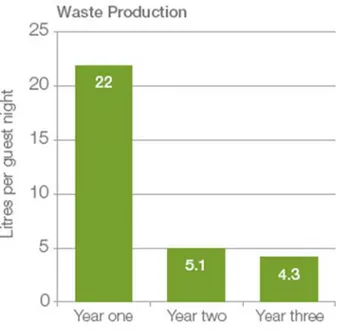(MASTER THESIS)
COMPARISON OF SUSTAINABLE HOTEL DESIGN
EXAMPLES USING PERFORMANCE INDICATORS
Duygu KANBUL YÜKSEL
Thesis Advisor: Assist. Prof. Dr. Eray Bozkurt
Department of Interior Architecture
Bornova-İZMİR 2013
YASAR UNIVERSITY
GRADUATE SCHOOL OF NATURAL AND APPLIED SCIENCES
COMPARISON OF SUSTAINABLE HOTEL DESIGN
EXAMPLES USING PERFORMANCE INDICATORS
Duygu KANBUL YÜKSEL
Thesis Advisor: Assist. Prof. Dr. Eray Bozkurt
Department of Interior Architecture
Bornova-İZMİR 2013
This study titled “Comparison of Sustainable Hotel Design Examples Using Performance Indicators” and presented as Master Thesis by Duygu Kanbul Yüksel has been evaluated in compliance with the relevant provisions of Y.U. Graduate Education and Training Regulation and Y.U. Institute of Science Education and Training Direction and jury members written below have decided for the defense of this thesis and it has been declared by consensus / majority of votes that the candidate has succeeded in thesis defense examination dated 24.05.2013.
Jury Members: Signature:
Head: Assist. Prof. Dr. Eray BOZKURT ...
Rapporteur Member: Assist. Prof. Dr. Gülnur Ballice ...
TEXT OF OATH
I hereby certify with honor that this MSc/Ph.D. thesis titled “COMPARISON of SUSTAINABLE HOTEL DESIGN EXAMPLES USING PERFORMANCE INDICATORS” was written by me, without aid that would not comply with scientific ethics and academic traditions, that the bibliography I have used is that indicated in this thesis and that appropriate reference has been given whenever necessary.
24/05/2013
ÖZET
SÜRDÜRÜLEBİLİR OTEL TASARIM ÖRNEKLERİNİN PERFORMANS KRİTERLERİ İLE KARŞILAŞTIRILMASI
KANBUL YÜKSEL, Duygu
Yüksek Lisans Tezi, İç Mimarlık Bölümü Tez Danışmanı: Assist. Prof. Dr. Eray BOZKURT
Mayıs 2013, 124 sayfa
Binaların çevre üzerindeki negatif etkileri; sera gazı ve toksik gaz yayılımı günden güne artmaktadır. Sürdürülebilir tasarım prensipleri ile çevre üzerindeki negatif etkiyi azaltmak hedeflenmektedir. Günümüzde turizm sektörünün sürdürülebilir olması için çalışmalara başlanmıştır. Bununla ilgili yönetmelikler, tasarılar gözden geçirilmektedir. Bu konudaki bilinç ve duyarlılığı arttırmak için çeşitli çalışmalar yapılmaktadır. Sürdürülebilir turizm bağlamında, çevreye duyarlı yaklaşımlar ile binalar üretilerek, sürdürülebilirliğin sağlanması temel sorumluluklar içinde yerini almaktadır.
Bu çalışmada, öncelikle sürdürülebilir bir otel tasarımındaki problemler, literatür araştırması sayesinde, belirlenmiştir. Tez kapsamında, sürdürülebilir otel yapımına yönelik olarak kriterler belirlenerek, yaklaşımlar geliştirerek dünya ülkeleri üzerinde çevre koruma bilincine duyarlı tasarlanmış otel örnekleri incelenmiş ve elde edilen bulgular derlenmiştir.
Çalışmanın amacı, otel yapılarında, malzeme seçimi, verimli enerji tasarımı, su tüketimi, etkili iç mekân hava kalitesi sağlanması, verimli gün ışığı kullanımı, yapısal form ve atık yönetimi gibi yedi tasarım başlığı adı altında toplanan sürdürülebilir tasarım kriterlerinin örnekler üzerinden incelenmesi, akış şemalarının hazırlanması ve aralarında karşılaştırma yapılmasıdır. Bu tez, otel yapılarının tasarımına katkı sağlayabilecek kaynak niteliğinde bir çalışmadır.
ABSTRACT
COMPARISON of SUSTAINABLE HOTEL DESIGN EXAMPLES USING PERFORMANCE INDICATORS
KANBUL YUKSEL, Duygu
M.Sc. in Interior Architecture
Supervisor: Assist. Prof. Dr. Eray BOZKURT May 2013, 124 pages
Negative effects of the buildings on the environment such as emission of the greenhouse gas and the toxic gas increases from day to day. It is aimed to reduce these kinds of negative effects on the environment with the aid of sustainable design criterions. In the present day, numerous studies related to the sustainability of tourism sector have been started. All the regulations and the legislations concerned with these issues are reviewed. In the meanwhile, in order to raise the consciousness and the mental capacity of the people about this issue, quite numbers of studies are carried out. In the context of sustainable tourism, maintaining the sustainability by constructing the buildings with the approaches that are sensitive to environment, take the place of basis responsibilities.
In this study, first of all, in order to obtain sustainable hotel design, literature reviews have been accomplished and using these data, designation problems related to hotel design have also been specified. In content of this thesis, criterions with respect to the sustainable hotel design have been determined and in the meantime concerned approaches have been developed. At the same time wide range of samples of the hotel designed with the intention of eco-friendly and also sensitive to consciousness of protection of the environment have been investigated and the findings have been compiled properly.
As part of the aim of this study, wide range of hotel samples have been examined and prepared the flow charts and also compared each other’s in terms of the seven sustainable design criterions including choice of the suitable materials, productive energy design, water consumption, ensuring the effective air condition in the interior site of the hotels, use of day light effectively, structural form and the management of contaminants. However this study will contribute all the hotel structures and is the sample for design studies in Turkey and also considered as the source study in literature.
Key Words: Sustainability, Design Criteria, Tourism, Hotel, Interior Architecture.
ACKNOWLEDGEMENTS
First of all, I wish to express my deepest gratitude to Assist. Prof. Dr. Eray BOZKURT the supervisor of this thesis, for his kind guidance, criticism and encouragement throughout the work.
I owe special thanks to many friends, mainly to Nilhan KILIÇ, Arzu ADAK, Canan ALGAR for their valuable help. I would like to thank Saffet GÖZLÜKAYA and Oğuz AKÇURA for their support and encouragement.
Last, but not least, I would like to express my deepest gratitude to my parents Ali Kemal & Kevser KANBUL and to my husband Enis YUKSEL for their support in every aspect of my life. This thesis would have not been possible without their support.
TABLE OF CONTENTS
Page
ÖZET ... v
ABSTRACT ... vi
ACKNOWLEDGEMENT ... viii
INDEX OF FIGURES ... xii
INDEX OF TABLES ... xv
INDEX OF ABBREVEATIONS ... xvi
1. CONCEPTUAL FRAMEWORK ... 1
1.1 Introduction ... 1
2. SUSTAINABLE TOURISM AND ENVIRONMENTAL AWARENESS ... 10
2.1 Definition of Sustainable Tourism ... 10
2.1.1 World tourism organization (UNWTO) ... 12
2.1.2 Tourism and the climate change ... 12
2.1.3 Global sustainable tourism criteria and council ... 13
2.2 Environmental Awareness of Sustainable Hotel Design ... 13
2.2.1 Hotel design of environmental awareness ... 14
2.2.2 Hotel management of environmental awareness ... 15
2.2.3 General guidelines to environmental management at hotels ... 16
2.2.4 Evaluation system in western civilization ... 16
2.2.5 Evaluation system in Turkey ... 21
3. SUSTAINABLE HOTEL DESIGN PERFORMANCE INDICATORS ... 24
3.1 The Concept of Sustainability in the Hotel Industry ... 24
3.1.1 Global hotel industry and the environment ... 25
3.1.2 Sustainable development of the hotel industry ... 26
3.2. Hotels Interior Design Criteria ... 27
3.2.1 Definition of Hotel ... 27
3.2.2 Types of hotel or classification of hotel by type ... 27
TABLE OF CONTENTS (cont.)
Page
3.3 Sustainable Hotel Design Performance Indicators ... 35
3.3.1 Material consumption ... 36
3.3.2 Energy efficiency ... 39
3.3.3 Water consumption ... 42
3.3.4 Efficient indoor air quality ... 45
3.3.5 Efficient daylight saving ... 47
3.3.6 Structural form ... 48
3.3.7 Waste management ... 49
4. CASE STUDY: EVALUATION of SELECTED HOTELS USING SUSTAINABLE CRITERIA INDICATORS ... 54
4.1 Sustainable Hotel Buildings ... 54
4.1.1 Example 1: Friend House Hotel ... 55
4.1.2 Example 2: Stadthalle Hotel ... 62
4.1.3 Example 3: Whitepod Eco Hotel ... 68
4.1.4 Example 4: ALT Hotels ... 74
4.1.5 Example 5: The Scarlet Hotel ... 77
4.1.6 Example 6: Vigilius Mountain Resort ... 80
4.1.7 Example 7: Innhouse Eco Hotel ... 84
4.1.8 Example 8: Pedras Salgadas Eco-Resort ... 89
4.1.9 Example 9: H2 Hotel ... 94
4.1.10 Example 10: Ecotourism Center ... 100
4.1.11 Example 11: Crowne Plaza Hotel Brussels ... 104
4.1.12 Example 12: Hilton Garden Inn Otel ... 109
4.1.13 Example 13: İber Hotel Sarigerme Park ... 112
4.1.14 Conceptual Frame Work: Haptik Otel ... 116
5. RESULT: COMPARISON of PROPOSED SUSTAINABLE INDICATORS of SELECTED 13 HOTEL EXAMPLES ... 118
TABLE OF CONTENTS (cont.)
Page
BIBLIOGRAPHY ... 122
INDEX OF FIGURES
Figure Page
Figure 2.1 Green Globe Point Allocation ... 17
Figure 2.2 BREAM Point Allocation ... 18
Figure 2.3 LEED Point Allocation ... 21
Figure 3.1 Loews Hotel Exterior View ... 30
Figure 3.2 Morgans Hotel Exterior View. ... 30
Figure 3.3 Hotel Luzern Exterior View and Hotel Luzern Interior View ... 31
Figure 3.4 Sorat Hotel Exterior View ... 32
Figure 3.5 W Hotel Exterior View. ... 33
Figure 3.6. Basic relationship of architecture to global warming with tourism and the state seven sustainable principles ... 35
Figure 3.7 Example of sustainable material use in hotel room ... 37
Figure 3.8 Characteristics of sustainable materials. ... 38
Figure 3.9. Sustainable product checks list parts. ... 39
Figure 3.10 Energy efficient design chart ... 38
Figure 3.11 Efficient fixture usage in hotel room ... 41
Figure 3.12 Water consumption chart. ... 44
Figure 3.13 Water efficient equipment and systems ... 44
Figure 3.14 Air quality chart ... 45
Figure 3.15 Better indoor air quality and energy efficient for HVAC ... 46
Figure 3.16 Natural ventilation ... 46
Figure 3.17 Efficient daylight saving ... 47
Figure 3.18 Optimization of natural light with artificial lighting ... 48
Figure 3.19 Structural form parts ... 48
Figure 3.20 Waste material chart ... 51
Figure 3.21 Waste material percantage of chart ... 52
Figure 3.22 Waste material percantage ... 52
Figure 3.23 Waste material percantage in hotel ... 53
Figure 4.1 Friend House Hotel- General View ... 55
Figure 4.2 Friend House Hotel- General View ... 56
Figure 4.3 Friend House Hotel- Park Zones Landscape Plan ... 57
INDEX OF FIGURES (cont.)
Figure Page
Figure 4.5 Friend House Hotel- Structural Form View . ... 58
Figure 4.6 Friend House Hotel- General Layout of 3D ... 58
Figure 4.7 Friend House Hotel- Interior. ... 59
Figure 4.8 Friend House Hotel- Interior ... 59
Figure 4.9 Friend House Hotel- Interior ... 60
Figure 4.10 Stadthalle Hotel - General View ... 62
Figure 4.11 Stadthalle Hotel - General View. ... 63
Figure 4.12 Stadthalle Hotel - Inner Garden ... 64
Figure 4.13 Stadthalle Hotel - Exterior Necessary- Solar Panel ... 64
Figure 4.14 Stadthalle Hotel – Interior View ... 65
Figure 4.15 General View of White Eco Hotel . ... 68
Figure 4.16 View of Dome in Winter ... 69
Figure 4.17 View of Dome in Winter ... 70
Figure 4.18 Detail View of Dome . ... 70
Figure 4.19 Interior View of Dome ... 71
Figure 4.20 The Ecological Policy of White Pod . ... 73
Figure 4.21 General View of ALT Hotel ... 74
Figure 4.22 Interior View of ALT Hotel. ... 75
Figure 4.23 General View of the Scarlet Hotel . ... 77
Figure 4.24 Interior View of the Scarlet Hotel . ... 78
Figure 4.25 General View of Vigilius Mountain Resort ... 80
Figure 4.26 Plan of Vigilius Mountain Resort ... 81
Figure 4.27 Facade of Vigilius Mountain Resort ... 82
Figure4.28 Interior view-plan of Vigilius Mountain Resort ... 82
Figure 4.29 Interior view-of Vigilius Mountain Resort ... 83
Figure 4.30 General View of Innhouse Eco Hotel ... 84
Figure 4.31 Facade of Innhouse Eco Hotel ... 85
Figure 4.32 View of Innhouse Eco Hotel ... 86
Figure 4.33 Elevation of Innhouse Eco Hotel ... 86
INDEX OF FIGURES (cont.)
Figure Page
Figure 4.35 View of Innhouse Eco Hotel . ... 87
Figure 4.36 Courtyards View of Innhouse Eco Hotel ... 88
Figure 4.37 General View of Parque de Pedras Salgadas. ... 90
Figure 4.38 Plan of Parque de Pedras Salgadas ... 91
Figure 4.39 General View of Parque de Pedras Salgadas ... 91
Figure 4.40 Interior View of Parque de Pedras Salgadas . ... 92
Figure 4.41 Interior View of Parque de Pedras Salgadas ... 92
Figure 4.42 General View of H2 Hotel . ... 94
Figure 4.43 Plan of H2 Hotel ... 95
Figure 4.44 Green Roof General View of H2 Hotel ... 96
Figure 4.45 Roof View of H2 Hotel . ... 96
Figure 4.46 Facade of H2 Hotel ... 97
Figure 4.47 Interior of H2 Hotel ... 97
Figure 4.48 Interior of H2 Hotel . ... 98
Figure 4.49 Interior of H2 Hotel . ... 98
Figure 4.50 The tableau in H2 Hotel ... 99
Figure 4.51 Eco Tourism Center General View ... 101
Figure 4.52 The plan of the Ecotourism Center . ... 102
Figure 4.53 The sketch of the Ecotourism Center . ... 102
Figure 4.54 Wood detail-facade of Ecotourism Center ... 103
Figure 4.55 General View of Crown Plaza Hotel . ... 105
Figure 4.56 Interior View of Crown Plaza Hotel . ... 107
Figure 4.57 General View of Hilton Garden Inn ... 109
Figure 4.58 Plan of Hilton Garden Inn ... 110
Figure 4.59 Facade of Hilton Garden Inn ... 110
Figure 4.60 General View of İber Hotel Sarigerme Park ... 113
Figure 4.61 Beach View of İber Hotel Sarigerme Park . ... 114
Figure 4.62 Interior of Haptik Hotel ... 116
INDEX OF TABLES
Table Page
Table 4.1 Information about Friend House Hotel ... 56
Table 4.2 Friend House Environmental Awareness ... 61
Table 4.3 Information of Stadthalle Hotel. ... 62
Table 4.4 Stadthalle Hotel Environmental Awareness ... 66
Table 4.5 Properties of White Eco Hotel ... 68
Table 4.6 White pod Environmental Awareness ... 72
Table 4.7 Properties of ALT Hotel ... 74
Table 4.8 ALT Hotel Environmental Awareness ... 70
Table 4.9 Information about the Scarlet Hotel ... 77
Table 4.10 Scarlet Hotel Environmental Awareness ... 79
Table 4.11 Properties of Vigilius Mountain Resort ... 80
Table 4.12 Vigilius Mountain Resort Environmental Awareness. ... 83
Table 4.13 Properties of Innhouse Eco Hotel ... 85
Table 4.14 Innhouse Eco Hotel Environmental Awareness. ... 89
Table 4.15 Properties of Parque de Pedras Salgadas. ... 90
Table 4.16 Parque de Pedras Salgadas Environmental Awareness ... 93
Table 4.17 Properties of H2 Hotel. ... 94
Table 4.18 H2 Hotel Environmental Awareness ... 99
Table 4.19 Properties of Eco Tourism Center ... 101
Table 4.20 Ecotourism Hotel Environmental Awareness. ... 103
Table 4.21 Properties of Crown Plaza Hotel. ... 105
Table 4.22 Crown Plaza Environmental Awareness. ... 108
Table 4.23 Properties of Hilton Garden Inn. ... 109
Table 4.24 Hilton Garden Inn Hotel Environmental Awareness. ... 112
Table 4.25 Information of İber Hotel Sarigerme Park. ... 113
Table 4.26 Properties of İber Hotel Sarigerme Park ... 115
Table 4.27 Properties of 67 Interior of Haptik Hotel ... 116
Table 5.1 Comparison of Sustainable Hotel with Design Criteria ... 120
Table 5.2 The Numerical Value of Sustainable Design Criteria ... 121
INDEX OF ABBREVEATIONS
Kısaltmalar / Abbreviations
EIA Environmental Impact Assessment FSC Forest Stewardship Council
GSTC The Global Sustainable Tourism Council GBC Green Building Council
LEED Leadership in Energy and Environmental Design
UNWTO World Tourism Organization
USGBC U.S. Green Building Council
SEG Greenhouse Gas Emissions Indicator
1. CONCEPTUAL FRAMEWORK
This chapter tries to put the research topic in its setting of the way finding behavior and its relation with cognition. This preliminary chapter also introduces the basic research subject, goals and objectives of the study, as well as its research methods and its scope.
1.1 Introduction
Today global climate changes of the world’s most important actors are construction, tourism and transportation sectors which threatens the future of world. When we look at the structures in the world, 17% of fresh water resources, 25% of forest products consumption and 40% of energy sources are the results for the structures consumption. And the interviews with the hotel owner show that tourism structures share the consumption of 20% in Turkey. In addition, the tourism sector in the world SEG (Greenhouse Gas Emissions Indicator) and CO2 emissions are estimated to be approximately 5% of the produce. In this context, these will contribute to sustainable hotel that will be designed from now on (Simpson, 2008).
Some studies have found that the tourism industry is only interested in environmental protection so long as it reduces operating and activity costs (Akis, 2001). It is normal to expect that enterprises in the tourism sector will adopt energy-saving methods and proper disposal of solid waste only if they minimize the related expenditures; competitive markets require cost minimization and profit maximization for an enterprise to survive. In this context, while designed places, hotels, it’s possible by using today’s design approaches to environmental-friendly and sustainable buildings with sustainable tourism.
The hotel industry, because of the nature of its functions, characteristics, and services, consumes substantial quantities of energy, water, and non-durable products. It has been estimated that most environmental impacts created by the hotel industry can be attributed to site planning and facility management; excessive consumption of local and imported non-durable goods, energy, and water; and emissions into the air, water, and soil (APAT, 2002; Mensah, 2004; Trung & Kumar, 2005).
The pressure for improved environmental performance of hotels can be seen, therefore, as driven by a need to preserve the local environment, perceived benefits such an opportunity to reduce operating costs and sustaining competitive advantage, enforcement of environmental regulations, institutional pressures, and a growing demand by customers for environmentally friendly programs. (Bohdanowicz, 2005a, b; Le et al., 2006; Rivera, 2004; Vazques, Santos, & Alvarez, 2001).
Sustainability is a complex word that is hard to define and even more challenging to quantify. It was first brought into popular use in 1987 in the United Nations documents the Common Future, a report by the World Commission on Environmental and Development, which defined sustainable development as meeting ‘the need of the present without compromising the ability of future generations to meet their own’. Since then the term ‘sustainability’ and such expressions as ‘green’, ‘eco’ and ‘environmentally friendly’ have been used to describe a multitude of product and actions that show concern for the earth’s resources. The overuse of these terms has threatened to reduce the potency of their meaning (Strongman, 2007)
There is no greater potential for personal expression than building one’s own shelter. For this reason alone, every effort should be made to enable new building construction to be sustainable for generations to come. Today, we realize that to be truly sustainable, it is not enough to imagine methods of minimizing damage to the environment: instead the result must have a net positive impact on it (Foster, 2007).
The aim of the study is to emphasize and application criteria’s of hotels around the world including Turkey which claim to be sustainable and environmentally friendly. In this study sustainable design criteria are determined under the core indicators; material consumption, energy efficiency, water consumption, efficient indoor air quality, efficient daylight saving, structural form and waste management. Analysis of sustainable buildings, some criteria are preferred or not, by making survey to world example and Turkey examples. Consequently, in the light of information obtained, building design criteria considered in sustainable buildings are presented with a general outline.
An increasing population, rapid urbanization and natural resources being under threat have been the most important facts that created environmental problems today. When looking at the historical development process of hotel building designs built the aim to service to customer, it has been observed that they were designed within basic framework such as location, building with environmental design, furniture and interior space organization as a result of the inadequacy of laws and lack of standards. When one observes at the building environment around the world, 17% of fresh water resources, 25% of forest products consumption and 40% of energy sources are the results for the structures consumption (Esin and Yuksek, 2009). It is accepted that construction has also played an important role in the emergence of environmental problems. A growing population, rapid urbanization and natural resources being under threat have been the most important environmental problems today.
Designed appropriateness of the people who use spaces, holds an important place in the evaluation of space. There are some Architectural Design Assessment Criteria in Hotels;
1. Functional Eligibility conditions, 2. Positive Contact Terms of Conformity, 3. User Specified Eligibility,
4. Health and Comfort Conditions Eligibility, 5. Aesthetic Conditions Eligibility,
6. Revised Environmental Conditions Eligibility, 7. Economic Conditions Eligibility (Laçin, 2004).
These criteria affect the hotel design and stuck with always same materials, same structural form. For these reason, to change the design criteria of the hotel, we need new solutions to support these criteria and protect the environment. With the change of the logic, customer used to see functional and environmental friendly buildings.
In order to document the purpose of the study, written thesis, books, articles, web sites, magazines, photographs, technical drawings, some hotel data’s as well as correspondence with owner of the hotels have been used. Collected documents were arranged according to the content of sub-titles and text integrity. All the data obtained were turned into a thesis study as a written text upon executing necessary editing.
In this thesis, sustainable tourism, classifications of hotel by type, environmental awareness and sustainable hotel that have been include these researches. Thirty thesis of Turkish Council of Higher Education which related these topics analyzed.
The summaries of the main sources that were used within the scope and aim of this study are as follows.
Bohdanowicz P. (2001) and Kallhauge A. ‘Energy Efficiency and Conservation in Hotels- towards Sustainable Tourism’ thesis explained the designed and operated hotel facilities offer convincing environmental and socio cultural advantages, as well as attractive opportunities for sustainable business. And paper explains sustainable tourism, including the sustainable use of energy and other resources in the hotel sector.
Akis S. (2001) ‘Sustainable Tourism and Turkey’: Result of a field Research’ and Sweeting A. (2003) ‘Initiative for Sustainable Tourism Development’ Definition of sustainable tourism and world tourism organization explained in these theses. These researches show the tourism wrong applications. Development of the tourism explained with the causes.
Scott D. (2009) ‘Weather and Climate Information for Tourism’ article show the sustainable tourism effects and explain the logic them. Tourism developers, operators and destinations discuss with the climate changes. Application of weather and climate information in the sustainable tourism learned.
Gezici F. (2005) ‘Components of Sustainability Two Cases from Turkey’ thesis explained the development process and goals of sustainability in two internationally popular cultural destinations in Turkey. The study hypothesis was the rapid development and high concentration of tourism activities cause negative effects on the natural environment.
Romppanen J. (2010) ‘Increasing Environmental Awareness of Hotel Customers, Case: A Turkish Eco Hotel’ thesis give information about sustainable tourism, environmental impacts of tourism and about environmentally friendly ways of travelling and doing business.
Also show the ecotourism is a growing industry also in Turkey with the negative impacts, climate changes and pollution effects.
Bohdanowicz P. (2003) ‘Environmental Awareness in the Hotel Industry- Questionnaire Analysis- Draft of Final Report’ thesis explains the importance of the environmental awareness in the hotel. Questionnaire Analysis among the hotel customer in order to compare and verify opinion about some of the issues mentioned. And these changes will take positive direction, towards the sustainability explained.
Erdoğan N. (2009) ‘Environmental Protection Programs and Conservation Practices of Hotel in Ankara, Turkey’ researches explained the importance of hotel industry with the environmental protection programs. And waste management and energy conservation sustainable design indicators discussed.
Conbay N. (2008) ‘Green Certification System Evaluation in World’ researches explained the certification system importance and how many type certification systems used in the world and Turkey.
Yolcu E. (2006) ‘Hotel Interior, Environment, Design Principles’ thesis explained the definition of hotels with the type and stages that hotels have undergone until today, and to determine what kind of inputs a designer would need when he/she prepares the program of the needs of a hotel, and to apply the principles of architectural design planning of hotels.
Rutkin K. (2005) ‘User Preference of Interior Design Elements in Hotel Spaces’ thesis examines which variations of interior design elements are preferred by the hotel guests and which elements are most important to overall preference of the spaces. The scale, furniture type, material and access to day lighting elements explained.
Dilşad Ö. (2007) ‘Analyzed the Interior Hotel Design Examples’ thesis explained hotel definition, hotel types, design process and interior placements. This help to understand the hotel design principles and researches with the examples compared that design process learned.
Balikcioglu G. (2004) ‘Urban Convention Hotel Design Criteria and a Design Proposal for Ankara Case’ thesis explains the efficient, flexible and valid hotel design. Design need for the hotel and many examples were investigated.
Chan L. (2010) ‘Selection of Hotels: Is the sustainability of a building more important than its aesthetic appearance? ’ thesis show the sustainable hotel building rating system and sustainability performance indicators. This help to create the sustainable design performance indicators in this thesis.
Rafael J. (2011) ‘Cogeneration Supply By Bio-Energy for a Sustainable Hotel Building Management System’ article explained the development of an energy model based on a mixed system of renewable energy, with primary energy sources as solar and biomass. Environment friendly process aims the reduction of energy demand, costs and emissions. This energy model is a new sustainable standard about energy consumption efficiency such as electrical and thermal demands of a hotel building discussed.
Bohdanowicz P. (2005) ‘Sustainable Hotels Environmental Reporting According to Green Globe 21’ named thesis explained the developing and making available reliable tools for benchmarking environmental performance are important steps in the quest for sustainability in hotel facilities.
Şenel A. (2010) ‘The Examination of Sustainable Building Construction Principles And New Approaches’ purpose of this research is to explore the ideas and approaches developed towards sustainable building construction. Sustainable and Sustainable Development which are key concept that are derived to be a solution to environmental, economical and social issues described.
Priyadarsini R. (2009) ‘A study on Energy Performance of Hotel in Singapore’ article explained the energy performance of the hotel building. Building features and operational characteristics contributing to the variations in hotel energy performance were discussed. Energy consumption of hotels and proposal explained in the article.
Treberspurg M. (2010) ‘New Technical Solution for Energy Efficient Buildings’ article explained façade systems and types of the façade. Wood façade, solar active façade
systems, glass façade systems, energy façade systems, hybrid façade systems and green façade systems described with the examples.
Karagiorgas M. (2006) ‘HOTRES: Renewable Energies in the Hotels. An extensive technical tool for the hotel industry’ article explained the five renewable energy technologies. These renewable energies create the Sustainable hotel and affect the tourism industry. Beccali M. (2009) ‘An Empirical Approach for Ranking Environmental and Energy Saving Measures in the Hotel Sector’ article explained the energy saving and reduction of CO2 emissions.
Yıldız Y. (2008) ‘Retrofitting Existing Mass Housing for Energy Efficiency: A Case Study in Gaziemir Emlak Bank Housing Area, Izmir, Turkey’ thesis explain energy consumption and energy efficiency in Turkey.
Becker E. (2009) ‘The Proximity Hotel: A Case Study on Guest Satisfaction of Sustainable Luxury Environments’’ thesis explained the Sustainable Designs and guest satisfaction relation and help to development of the hotel.
The 2005 ‘World Sustainable Building Conference in Tokyo, Student Session Sustainable Building Design Book’ is to present those Sustainable buildings such as zero-emission refined buildings, passively designed energy saving building and water consumptions explained with the examples.
Ozgur M. (2008) ‘Review of Turkey’s renewable energy potential’ article describes the Global renewable energy status and Turkey renewable energy potential and its utilization explained. Climate change and C02 emission of Turkey detailed survey.
Zinzade D. (2010) ‘An Investigation of the Sustainability Formulating the High Rise Buildings’ article explain the sustainable buildings design and performance strategies and to state the sustainability strategies shaping the high rise buildings investigated throughout the study.
This study is to determine the sustainable design criteria for environmental friendly hotel design and to research the attained application results for the chosen locations. The design principles are identified and then evaluated. By analyzing various written sources, the
design difficulties of the research subject are revealed and evaluated. Information concerning environmental friendly sustainable hotels and certificates are conveyed in this study. In the light of this acquired information, sustainable principles have come up
In the first chapter, with the introduction; the aim, the method type to realize these objectives, scope of the study and limitations and the technique to be used during the data collection process are explained.
In the second chapter, ‘sustainable tourism and environmental awareness’ which forms the center of the study are discussed. Sustainable tourism was carried out with the global organizations, climates changes of tourism and the global sustainable tourism organization focused. ‘Environmental awareness of sustainable hotel design’ analyzed with the management and evaluation system of hotels. The evaluation system helps to create the 7 design criteria which will be explained in the next chapter.
In the third chapter, under the heading ‘Sustainable Hotel Performance Indicator’ concept of sustainability in hotel industry, global hotel industry and the environment and sustainable development of hotel explained. Under the heading ‘Hotel Interior Design Criteria’ and definition of hotel, types of hotel and the hotel design development in the world explained with the hotel picture. ‘Sustainable Hotel Design Performance Indicators’ were shown with the flow chart and compose the basis of this study. Limited with 7 sustainable design criteria of hotels which includes material consumption, energy efficiency, water consumption, efficient indoor air quality, efficient daylight saving, structural form and waste management.
In the fourth chapter, sustainable hotel examples designed in countries across the world were collected upon personal interviews with the hotel owner and managers were examined in the context of design criteria. These selected hotel examples analyzed with the seven design criteria; material consumption, energy efficiency, water consumption, efficient indoor air quality, efficient daylight saving, structural form and waste management.
In the fifth chapters, the examples which are explained in the chapter five are being compared with each other and with the use of point system, evaluation shows with tables. Analyzed hotel examples with the 7 sustainable hotel design criteria and named with poor,
weak, below average, average, above average, good and best. The comparison of the hotels explained with the table and evaluation described with the help of Pareto Principle. The Pareto principle (also known as the 80–20 rule, the law of the vital few, and the principle of factor sparsely) states that, for many events, roughly 80% of the effects come from 20% of the causes (http://en.wikipedia.org/wiki/Pareto_principle).
In the conclusion, the findings of the study carried out in accordance with the objectives and purposes are explained and recommendations are made for the future.
Sustainable hotel designs will gain importance when the significance of sustainable
tourism is realized all over the world. Therefore, customers recognizing their environmental responsibility will give importance to sustainable hotels to conserve the nature and protect the environment. In the light of these, the construction sector will develop in a sustainable manner, and the sustainable hotel design will become essential for more comfortable and healthy lives.
The scope of the study is collected under headings; Sustainable Tourism and environmental awareness and sustainable hotel design criteria, sustainable hotel buildings and comparison of hotels. The significance of ‘sustainable tourism’ chapter help to understood, why we need sustainable hotel design.
Importance of project to environment and construction details of sustainable hotels are described under the heading of ‘sustainable hotel design criteria’. And sustainable hotel design criteria’ chapter explained and discussed with the help of 14 Sustainable hotel Design examples which were claim to be a sustainable hotel. And the comparison of the hotels with the sustainable design criteria were explained.
This study is limited with 7 sustainable design criteria of hotels which includes material consumption, energy efficiency, water consumption, efficient indoor air quality, efficient daylight saving, structural form and waste management. The finding were organized, analyzed, and presented according to the categories. And the hotels which are selected for evaluation are claiming to be sustainable hotels.
2. SUSTAINABLE TOURISM AND ENVIRONMENTAL AWARENESS
In the second chapter the sustainable tourism and the relation with the environmental awareness were described under main and sub-headings. And today’s evaluation systems in Turkey and western civilization were described.
2.1. Definition of Sustainable Tourism
Tourism in the Green Economy refers to tourism activities that can be maintained, or sustained, indefinitely in their social, economic, socioeconomic, cultural, and environmental contexts: “sustainable tourism.” This term describes policies, practices and programs that take into account not only the expectations of tourists about responsible natural resource management (demand), but also the needs and quality of life of the environment and communities that support tourist projects (supply) (Romppanen, 2010).
The principles of sustainable tourism are based on the following factors:
(a) Changing patterns of resource consumption;
(b) Efficient use of the Earth’s natural resources through conservation and management of water and energy;
(c) Protection of our global commons through efficient energy use, environmentally Friendly transportation, efficient land use and resource development, and protection and management of the air, land, and oceans;
(d) Management of chemicals and wastes by prevention, reduction, and management of hazardous waste, reduction of solid wastes, reuse and recycling, and waste water Management; (e) site planning, use and management;
(f) Inclusion of staff, clients, and society in environmental issues;
(g) Development of partnerships to promote sustainable development; and (h) Sustainable planning (Mengi & Algan, 2003).
Turkey is not exempt from this discussion. Hence, it is necessary to assess the nature of Turkish policy and business practices in the tourism and travel industry to provide valuable information that can support policy development, the application of policy, and control of environmental impacts.
The European Union began to develop environmental policy and action plans in 1972. Since then, minimum standards and legal infrastructures have been established for waste recycling and water and air pollution. Environmental issues are included in the Union’s programs related to the Amsterdam Protocol because the existing legal provisions were found to be insufficient for the prevention of environmental pollution.
The Fifth Environmental Action Program was established for the 1993–2000 period. The inclusion of an environmental dimension in all work and every program carried out in the European Union became mandatory since the Fifth Environmental Action Program covered the industrial, energy, tourism, transportation, and agricultural sectors (Mengi & Algan, 2003). This suggests a need to discover whether Turkey’s hotel industry meets the internationally and nationally prescribed and expected standards.
There have been numerous studies of the environmental protection practices of hotels, but the majority has focused on large hotels catering to the demands of mass tourism on seashores and in popular resort areas (Romppanen, 2010). Inner-city hotels, and especially hotels in large cities, have generally been ignored. Contrary to the prevailing notion that only coastal hotels create environmental problems and take measures to solve or prevent them, inner-city hotels also create and solve environmental problems. Thus, it is necessary to determine the nature of the environmental policies and practices of city hotels in order to improve the knowledge of their status and their impacts and to develop and apply environmentally sound solutions (Romppanen, 2010).
Tourism can be regarded as one of the largest industries in the world as it offers employment for nearly 200 million people. Yearly there are approximately 800 million travelers and the number is expected to be doubled by the year 2020. (WWF, Finland). A huge number of visitors also put enormous stress on the environment. However, with responsible actions negative impacts on the environment can be minimized. Responsible actions apply to the whole sustainable Tourism industry (Romppanen, 2010).
Sustainable Tourism organization support by the World Tourism Organization (UNWTO), climate change and The Global Sustainable Tourism Council (GSTC). These are help to optimal use of environmental resources and support the Sustainable tourism.
2.1.1 World Tourism Organization (UNWTO)
UNWTO support the establishment of observatories of the Sustainable Tourism for Tourism destinations, through the use of systematic application of monitoring, evaluation and information techniques as key tools for the development of Sustainable policies (Romppanen, 2010).
UNWTO, Supporting Sustainable Tourism policies and practices which make optimal use of environmental resources, respect the socio-cultural authenticity of host communities and provide socio-economic benefits for all.
The World Tourism Organization is the United Nations agency responsible for the promotion of responsible, sustainable and universally accessible tourism.
As the leading international organization in the field of tourism, UNWTO promotes tourism as a driver of economic growth, inclusive development and environmental sustainability and offers leadership and support to the sector in advancing knowledge and tourism policies worldwide.
2.1.2 Tourism and the Climate Change
Climate change is one of the most serious threats to the economy and the environment. As climate defines the length and quality of tourism seasons, affects tourism operations and influences environmental conditions that both attract and deter visitors, the tourism and travel sector is highly-climate sensitive. Recognizing the high dependency of Tourism activities on climate conditions, and the high vulnerability of many destinations to climate change impacts, UNWTO launched the “Davos Process on climate change and tourism” named after an international conference held in 2007 (Romppanen, 2010).
Against this background, UNWTO jointly with the Secretariat of Tourism of Mexico held a side event at the Sixteen Conference of the Parties of the United Nations Framework Convention on Climate Change, in Cancun, Mexico, from 29 November to 10 December 2010. The side event presented the work undertaken so far by the tourism public and private sectors to mitigate greenhouse gas emissions, promote adaptation in Tourism businesses and destinations, invest in new technologies and support developing countries through financing. Participants also underlined the vulnerability of certain tourism destinations in developing countries to the devastating impacts of coral reefs, to the loss of basic tourism services such as water supply and food security. UNWTO presented as well its Hotel Energy Solutions project aimed at increasing energy efficiency and the use of renewable Energy technologies by SME hotels in the European Union (SDT E-Bulten, 2011).
2.1.3 Global Sustainable Tourism Criteria and Council
The Global Sustainable Tourism Council (GSTC) was established in August of 2010, as a body aiming at the dissemination and application of the Global Sustainable Tourism Criteria (GSTC) and its main goals for 2011 include the launch of an accreditation process, for existing Tourism certification programmers and of a market access strategy. (SDT E-Bulten, 2011)
2.2 Environmental Awareness of Sustainable Hotel Design
One of the leading obstacles to transforming environmental awareness into industrial practice is the assumed cost of environmental protection. Some studies have found that the tourism industry is only interested in environmental protection so long as it reduces operating and activity costs (Akis, 2001).
It is normal to expect that enterprises in the tourism sector will adopt energy-saving methods and proper disposal of solid waste only if they minimize the related expenditures; competitive markets require cost minimization and profit maximization for an enterprise to survive.
Studies in the US and Europe have mostly stated similar reasons on how to draw the attention of hotel industry to environmental protection. In Turkey, there is a lack of information about the level of environmental knowledge and interest of hotel managers and about the daily hotel practices related to environmental outcomes and protection (Akis, S. (2001).
2.2.1 Hotel Design of Environmental Awareness
The hotel designed to investigate the general nature of environmental awareness with the sustainable design criteria; material, energy and water use, indoor air quality, efficient daylight saving, structural form and waste management.
The objectives of the research were (Bohdanowicz, 2003):
By determining and discussing the environmental practices of hotels, to attract the attention of the hotel industry and other interested parties, including academics and researchers, to environmental issues and the world examples with parallel business cultures and practices.
To provide new information on the issue for a different location and distinctive business culture, thereby expanding the existing body of knowledge beyond previous localities and countries.
To contribute to the development of better environmental awareness and practices in Turkey and around the world, not only on the part of hotel industry but also on the part of every interested party, including policymakers, academics, researchers, the media, and related industries.
With these criteria’s in mind, hotels should be designed with the environmental awareness and environmental management will be supported and we will have sustainable livable world.
2.2.2 Hotel Management of Environmental Awareness
Hotel managements should plan to keep the energy and water consumption, and the usage of waste at minimum levels to raise environmental awareness.
There is no recent detailed data on the size of the hotel sector but it can be reasonably estimated at the level of over 360 000 facilities and 30 million beds worldwide (IH&RA 2000; JLLSH 2001).
Among commercial buildings, lodging facilities are unique with regard to operational schemes, the type of services offered, as well as the resulting patterns of the natural resource consumption. Hotel constitutes ‘a refuge far removed from the caves of everyday life’ (Bohdanowicz, 2003). They are designed to provide multi-facetted comfort and services to guests frequently accustomed to, and willing to pay for exclusive amenities, treatment and entertainment (Bohdanowicz, 2003).
Many of the services provided to hotel guests are highly resource intensive, whether it concerns energy, water or raw materials. As a consequence, hotels have been found to have the highest negative impact on the environment of all commercial buildings, with the expectation of hospitals (Rada, 1996). The environmental awareness among the hotel representatives in world, as well as to gather to information about the environmental indicatives already takes places within the industry.
As regards the incentives that would encourage hotel manager to undertake environmentally-oriented initiatives in their hotels, the possibility of reducing the operational costs is the one by far the most commonly pointed out (Bohdanowicz, 2003). Furthermore to decrease the negative environmental impacts has been underlined, together with the requirements of customers.
Renewable forms of energy are used, waste is sorted and purchasing is done in a responsible way. Hotels, or more broadly accommodation sector represents one of the most important subsectors of the travel and tourism industry.
2.2.3 General Guidelines to Environmental Management at Hotels
Environmental management at hotels is a planned and organized operation that minimizes the use of energy, water, waste and chemicals. Instead, renewable forms of energy are used, waste is sorted and purchasing is done in a responsible way. The use of the above-mentioned issues is regularly monitored with regards to amount and cost. In addition, staff members are regularly educated to work according to the company’s environmental values.
Environmental conservation is essential and the maintenance of the surroundings is done according to the principles of sustainability, for instance by planting local plants, collecting rainwater for watering the garden and using as little asphalt as possible. Further on, cooperation with environmentally responsible organizations is important (Diamantis, 2001).
This part takes a closer look at hotels, their sustainability and environmental management as a part of the larger tourism industry. Sustainability at Hotels today is starting to be a requirement in order for a hotel to keep up with the growing competition. There will be a growing demand for sustainable hotels in the future, not only because of customer demand but also because of the increased awareness of the state of the environment.
When a hotel commits to environmental protection, it not only brings environmental benefits but also cost savings and increased profitability for the hotel, preserves the hotel’s natural assets and surroundings and enhances its image and reputation as an environmentally responsible hotel, which especially today is becoming a factor of choice for the customers (Han, Hsu & Sheu 2010).
2.2.4 Evaluation system in western civilization
In this part the concept of evaluation system in western civilization was defined and described under sub-headings. Evaluation Systems in western Civilization are Green Globe, BREAM and LEED choose and described with the certificate examples.
2.2.4.1 Green globe
Green Globe is the global travel and tourism industries’ certification program for sustainable tourism. Green Globe Members save energy and water resources, reduce operational costs, positively contribute to local communities and their environment and meet the high expectations of green leisure and business travelers.
Green Globe certification can be performed in English, Spanish, French, German, Chinese and Portuguese. The Green Globe Solution Center is the online community for sustainability knowledge and advice.
Global marketing via Green Globe Public Relations reaches over 450,000 travel professionals worldwide. Green Globe Members attract green leisure and business travelers via the Green Globe App. Green Globe Preferred Partners operate in 83 countries, providing Members local access to professional sustainable tourism consultants and Green Globe Accredited Auditors. Sustainability training for Members and other professionals is offered via the (Green Building Initiative, 2013)
Figure 2.1 Green Globe Point Allocation (Green Building Initiative, 2013)
2.2.4.2 BREAM
BREAM is the world's foremost environmental assessment method and rating system for buildings, with 250,000 buildings with certified BREAM assessment ratings and over a million registered for assessment since it was first launched in 1990.
BREAM sets the standard for best practice in sustainable building design, construction and operation and has become one of the most comprehensive and widely recognized measures of a building's environmental performance. It encourages designers, clients and others to think about low carbon and low impact design, minimizing the energy demands created by a building before considering energy efficiency and low carbon technologies.
A BREAM assessment uses recognized measures of performance, which are set against established benchmarks, to evaluate a building’s specification, design, construction and use. The measures used represent a broad range of categories and criteria from energy to ecology. They include aspects related to energy and water use, the internal environment health and well-being, pollution, transport, materials, waste, ecology and management processes.
Clients, planner’s development agencies, funders and developers use BREAM to specify the sustainability performance of their buildings in a way that is quick, comprehensive, and highly visible in the marketplace and provides a level playing field. Property agents use it to promote the environmental credentials and benefits of a building to potential purchasers and tenants.
Design teams use it as a method to improve the performance of their buildings and their own experience and knowledge of environmental aspects of sustainability. Managers use it to reduce running costs, measure and improve the performance of buildings, empower staff, develop action plans and monitor and report performance at both the single building and portfolio level (http://www.breeam.org/about.jsp?id=66: UPDATE 10.04.2013).
2.2.4.3 LEED
Leadership in Energy and Environmental Design (LEED) consists of a suite of rating systems for the design, construction and operation of high performance green buildings, homes and neighborhoods.
Developed by the U.S. Green Building Council (USGBC), LEED is intended to provide building owners and operators a concise framework for identifying and implementing practical and measurable green building design, construction, operations and maintenance solutions.
Since its inception in 1993, the U.S. Green Building Council has grown to encompass more than 7,000 projects in the United States and 30 countries, covering over 1.501 billion square feet (140 km²) of development area .
Today, LEED consists of a suite of nine rating systems for the design, construction and operation of buildings, homes and neighborhoods. Five overarching categories correspond to the specialties available under the LEED Accredited Professional program. That suite currently consists of:
Green Building Design & Construction
LEED for New Construction
LEED for Core & Shell
LEED for Schools
LEED for Retail: New Construction and Major Renovations
LEED for Healthcare
Green Interior Design & Construction
LEED for Commercial Interiors
Green Building Operations & Maintenance
LEED for Existing Buildings: Operations & Maintenance
Green Neighborhood Development
LEED for Neighborhood Development
Green Home Design and Construction
LEED for Homes
LEED certified buildings are intended to use resources more efficiently when compared to conventional buildings simply built to code. LEED certified buildings often provide healthier work and living environments, which contributes to higher productivity and
improved employee health and comfort (http://en.wikipedia.org/wiki/Leadership_in_Energy_and_Environmental_Design, UPDATE
10.04.2013)
The LEED Green Building Rating System for Commercial Interiors is a set of performance standards for certifying the design and construction of tenant spaces for office, restaurant, healthcare, hotel/resort and education buildings of all sizes, both public and private.
The intent is to promote healthful, durable, affordable, and environmentally sound practices in tenant space design and construction (Appendix 1-2). Prerequisites and credits in the LEED for Commercial Interiors Rating System address 7 topics:
Sustainable Sites (SS) Water Efficiency (WE) Energy and Atmosphere (EA) Materials and Resources (MR) Indoor Environmental Quality (IEQ) Innovation in Design (ID)
Regional Priority (RP)
LEED for Commercial Interiors certifications are awarded according to the following scale:
Certified 40 – 49 points Silver 50 – 59 points Gold 60 – 79 points
Platinum 80 points and above
In the thesis from Leed Evaluation system; Green Interior Design & Construction categories of Commercial Interiors rating systems 7 point choose as a hotel design criteria’s.
Figure 2.2 LEED Point Allocation (http://www.leed.org/about.jsp?id=66)
2.2.5. Evaluation system in Turkey
In this part the concept of evaluation system in Turkey was defined and described under sub-headings. Evaluation Systems in Turkey are Environment protection programs, Bep-TR, Green Starts choose and described with the certificate examples.
2.2.5.1 Environmental protection programs
In the protection of environment program in Turkey, Environmental Impact Assessment and The Turkish Ministry of Culture and Tourism, Bep-TR and Green Star support to create sustainable hotel design.
According to Turkey’s Environmental Impact Assessment (EIA) regulation, hotels with 50 or more guest rooms must prepare an environmental impact assessment report (ÇED, 2003), but only 20% of the sampled hotels had produced an EIA report. Only 1 four-star and 1 three-star hotel had a written environmental policy, program, and EIA report, whereas 3 of 7 five-star (42.9%), 11 of 17 four-star (64.7%), and 11 of 16 three-star hotels (68.8%) had no environmental policy, program, or EIA report (Erdoğan, Baris, 2006).
The Turkish Ministry of Culture and Tourism started an environmental sensitivity campaign in 1992 to encourage the tourism industry to contribute to environmental protection and conservation in their daily practices. At the request of a hotel, the Ministry would visit the hotel and award a ‘‘friend of the environment’’ certificate called the Pine Award if the hotel met the standards of the award program.
These standards include harmony of the facility with nature, the choice of materials used in construction, the selection and use of landscape elements, isolation measures taken against noise, the quality and quantity of materials used for decoration of the facility, the measures and arrangements taken for energy and water conservation, the measures taken for fire prevention, the arrangements for waste management, wastewater treatment and reuse, kitchen and service materials used, the quality and quantity of consumables (e.g., detergents, disinfectants, and shampoos), environmental education materials (e.g., brochures and posters) for visitors, and environmental training of the staff (Erdoğan and Baris, 2006).
2.2.5.2 Bep-TR
Bep-TR is the method for calculating the energy performance of buildings in Turkey. The method of calculation, residential, office, education, health care buildings, hotels, shopping and commercial centers, such as the building typologies can be used to assess the energy performance of existing and new buildings.
All the parameters that affect the energy consumption of buildings assess the impact of energy efficiency and developed to determine energy performance (Sev, 2008).
Specifically, the method which shows the calculation of energy can be obtained of the net output energy and as a result of step; the need for heating and cooling of the building of the annual net energy (Appendix 3).
Evaluation of the method of calculation the buildings performance (Sev, 2008);
Calculation the amount of energy needed for heating and cooling of the building. Determination of the total heating and cooling energy consumption of the building. Determination of the Ventilation of energy Consumption
The effects of the sunlight to building and the period which is untapped of daylight and sunlight areas calculation done for the energy demand and consumption.
Calculation of the sanitary hot water which is needed for the of energy consumption.
2.2.5.3 Green Stars
Green Star applications; aim is to environmental protection, environmental awareness, development of environmentally friendly constructions and tourist accommodation establishments promoting entrepreneurship characteristics.
Within the scope of the General Directorate of the Ministry of Culture and Tourism Investment Businesses, environmental policy, energy consumption, periodic maintenance and
repair of installations and a personnel providing environmental education ‘Green Star’ is one of the criteria. Plants 'Green Star' and contribute to the protection of the environment without compromising on quality makes (Sev, 2008).
In addition, water conservation, increase energy efficiency, environmental consumption, reducing the amount of hazardous substances and waste, to promote the use of renewable energy resources from the stage of investment to planning, accommodation establishments must be environmentally sensitive, touristy plant of adaptation to the environment, beautification the regulatory environment, awareness of the environmental sensitivity, collaboration with the relevant institutions are try to secure with Culture and Ministry of Tourism until 1993 Sev, 2008) (Appendix 4).
These evaluation systems in Western Civilization and Turkey help to understand the sustainable building design criteria.
3. SUSTAINABLE HOTEL DESIGN PERFORMANCE INDICATORS
In this chapter, under the heading of Sustainable Hotel Design performance indicators, sustainable hotel industry, global hotel industries were explained. Sustainable hotel design performance indicators were described with the flow chart.
3.1 The Concept of Sustainability in the Hotel Industry
In light of the growing environmental degradation, society is becoming increasingly aware of the need of adopting and enforcing more effective measures of environmental protection. Sustainable development, including the development of a more sustainable built environment, has thus become a vital priority and a veritable challenge of the time. The issue of sustainability should be addressed at all levels, in cooperation with policy makers, academia, industry, the general public and many other stakeholders. A number of factors indicate that the hotel industry has an important responsibility in this process (Bohdanowicz, 2005).
3.1.1 Global hotel industry and the environment
Although hotels typically represent less than 5% of a nation’s building stock (Bohdanowicz, 2004), the global hotel industry, comprising over 300 000 facilities, constitutes one of the most important sectors of the tourism industry (Olsen, 2000). Hotels provide accommodation to half of all national and international visitors (EC, 1998), which, in Europe alone, account for 160-200 million international visitors per year (WTO, 2004).
Due to the high level of resource utilization (energy, water, consumables) in hotel facilities, the environmental footprint of hotels is typically larger than those of other types of buildings of similar size (Rada, 1996). According to Perrera (2003), the entire American lodging industry (including hotels, dormitories and other accommodation facilities) was estimated to consume 55.6 twh of energy/year in 2000, while the corresponding figure for European facilities was 39 twh (Choose, 2001).
The prevalence of fossil-fuel generated power translates into commensurate emissions of carbon dioxide, particulates, nitrogen and sulphur oxides, and other air pollutants, both locally and globally. It is estimated that a typical hotel releases between 160 and 200 kg of carbon dioxide per m2 of room floor area annually, depending on the fuel used to generate electricity, heating, or cooling (Chan and Lam, 2002).
Bohdanowicz (2005) estimates that European hotels emit more than 10 mega tones of CO2. There is no collective data for hotel water consumption on a global, or a European scale, but according to Davies and Cahill (2000) tourists in the American lodging industry consume approximately 174.88 million m3 of water annually.
Most of the water consumed is released in the form of sewage, requiring adequate treatment. Since hotels are large users of consumer goods, waste generation is one of the more visible impacts the hotel industry has on the environment. According to and HER (2004) estimate, a typical hotel produces in excess of 1 kg of waste per guest-day, which, for a typical facility, results in many tons of waste each month. These figures illustrate the urgent need for more environmentally sound practices and products in the hotel industry.
3.1.2 Sustainable development of the hotel industry
Until quite recently, the hotel industry has been rather oblivious of the extent of environmental damage caused by its services and operations. The last two decades, however, have brought about an increased environmental awareness among the general public, the emergence of social environmental movements, and the development of the concept of “green consumerism”.
This has eventually spurred growing criticism of existing tourism/hotel practices. In the recent past, environmental responsibility has been receiving more attention in the hotel industry and is now increasingly becoming a corporate issue. However, in order to achieve greater environmental responsibility, proper implementation tools and strategies are necessary. The primary instruments of action include the enforcement of relevant laws and regulations (health and safety requirements, planning and building regulations, laws relevant to water utilization, waste generation and the release of emissions), the levying of environmental taxes (e.g. based on the amount of water and energy used), as well as voluntary standards.
The latter are generally less binding, and provide guidelines indicating specific levels of environment-related performance that ought to be achieved. Certification and labeling schemes offered internationally, nationally or locally by industrial organizations, governmental and nongovernmental institutions are increasingly growing in popularity. In order to assist hoteliers in running more environmentally responsible businesses, branch associations, academic communities and hotel companies themselves continue to develop guidelines, manuals and training modules (Bohdanowicz, 2004). Hoteliers are increasingly aware that the environment and its protection are crucial to hotel industry development and performance.
3.2. Hotel Interior Design Criteria
3.2.1 Definition of Hotel
A hotel is an establishment that provides lodging paid on a short-term basis. The provision of basic accommodation, in times past, consisting only of a room with a bed, a cupboard, a small table and a washstand has largely been replaced by rooms with modern facilities, including en-suite bathrooms and air conditioning or climate control. Additional common features found in hotel rooms are a telephone, an alarm clock, a television, a safe, a mini-bar with snack foods and drinks, and facilities for making tea and coffee (http://en.wikipedia.org/wiki/Hotel).
Luxury features include bathrobes and slippers, a pillow menu, twin-sink vanities, and jacuzzi bathtubs. Larger hotels may provide additional guest facilities such as a swimming pool, fitness center, business center, childcare, conference facilities and social function services (http://en.wikipedia.org/wiki/Hotel).
Hotel rooms are usually numbered to allow guests to identify their room. Some hotels offer meals as part of a room and board arrangement. In the United Kingdom, a hotel is required by law to serve food and drinks to all guests within certain stated hours. In Japan, capsule hotels provide a minimized amount of room space and shared facilities. In Turkey, hotels are different services depends on the type; holiday hotel or business hotel (http://en.wikipedia.org/wiki/Hotel).
3.2.2 Types of hotel
From 19. Century, hotel's types divided 2; type of service and according to the accommodations (Önder, 1995). Hotels are classified according to the hotel size, location, target markets, levels of service, facilities, number of rooms, ownership and affiliation etc.
Size - or number of rooms
Under 150 rooms 150 to 299 rooms 300 to 600 rooms More than 600 rooms
These categories enable hotels of similar sizes to compare operating procedures and statistical results.
Target markets
Hotels target many markets and can be classified according to the markets they attempt to attract their guests. Common types of markets include business, airport, suites, residential, resort, timeshare, casino, convention and conference hotels.
o Business Hotels: These hotels are the largest group of hotel types and cater primarily to
business travelers and usually located in downtown or business districts. Although business hotels primarily serve business travelers, many tour groups, individual tourists and small conference groups find these hotels attractive.
o Airport Hotels: These type of hotels typically target business clientele, airline passengers
with overnight travel layovers or cancelled flights and airline personnel.
o Suite Hotels: These kinds of hotels are the latest trend and the fastest growing segments
in the hotel industry. Main attraction of these hotels is guestrooms with a living room and a separate bedroom. In exchange for more complete living room suite hotels generally have fewer and more limited public areas and guest services than other hotels.
o Extended Stay Hotels: Extended stay hotels is somewhat similar to the suite hotels, but
usually offers kitchen amenities in the room. These kind of hotels are for travelers who want to stay more than a week and does not want to depend on the service of the hotel.
